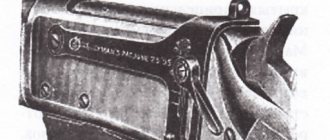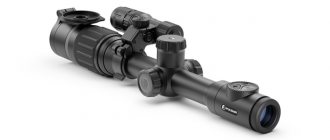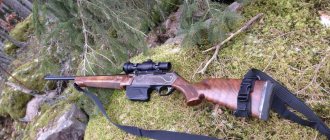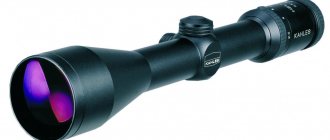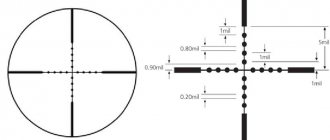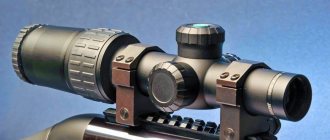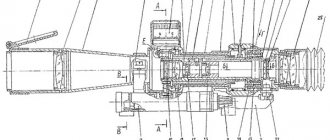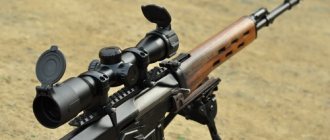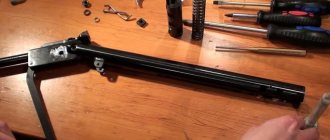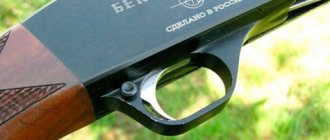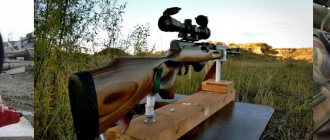The best domestic optical sights Veber
Veber optical devices are available in different types and differ in technical characteristics, capabilities and purpose. The Veber series of sights includes: Black Russian, Wolf, Black Fox, Dioptric, Brave Hare and air rifle sights. Let's highlight the main advantages of this brand:
- high-quality optics have good light transmittance without image distortion;
- the housing is made of aircraft-grade aluminum, filled with nitrogen to prevent fogging, and has high protection against dust and moisture;
- equipped with an accurate system for entering height and horizontal corrections;
- models with high magnification have parallax adjustment;
- The devices use a powerful spiral spring, thanks to which the aiming mark does not need to be constantly adjusted.
Optical sights Veber Wolf
Veber's flagship riflescope is the Veber Wolf line. The range includes the following models: 1-4 x 24 GB DnD, 1.25-4.5 x 26 IR DnD, 3-9 x 42 IR, high magnification 4-16 x 44 SF IR and others. A wide range of models allows you to choose a scope from this series for any type of hunting.
The Veber Wolf line is different:
- · optimal combination of price and quality;
- · high impact resistance - up to 7000 J, which means the devices can be installed on high-caliber weapons;
- · a special design that prevents damage to the lenses by branches when a hunter walks through the forest.
The variable magnification of the devices allows the optical sight to be used not only for aimed shooting, but also for shooting “offhand”, from the approach and for driven hunting.
Optical sights Veber Black Russian
The Veber Black Russian line of optical devices is a new product from Veber, which successfully uses the latest generation technologies. The video can be viewed here.
The Veber Black Russian series includes 5 models of sights that have all the necessary characteristics at a very attractive price. Among them you can choose a sight suitable for specific hunting conditions:
- Veber Black Russian 1-4 x 24 RG are excellent for driven hunting;
- Veber Black Russian 4-14 x 50 TSS RG and 3-9 x 44 TSS RG are universal sights for various distances, allowing you to make an accurate shot even in low light conditions;
- Veber Black Russian 6 x 40 TSS RG - for hunting at close and medium distances during the day and at dusk;
- Veber Black Russian 2-7 x 32 TSS RG - for hunting from the approach and from an ambush.
All samples are tested in the Veber testing laboratory.
Veber Black Fox Optical Sights
The Veber Black Fox line of optical sights is designed for walking and driven hunting of small and medium-sized animals, as well as large birds. These devices are inexpensive and are among the best-selling today.
The line includes models with fixed and variable magnification; the latter can have different magnifications and different lens sizes, which allows you to make the best choice for your type of hunting. The main features of Veber Black Fox sights are as follows:
- high image quality thanks to multi-layer coating of lenses, light transmission of more than 85%;
- smooth increase;
- convenient illumination of the grid in the form of a red dot with brightness adjustment;
- precise adjustment mechanism with clearly audible clicks.
Veber Black Fox optical sights were successfully tested on the Dragunov sniper rifle at the Rzhevka training ground, where firearms are tested for the troops of the Russian Federation.
↑ Device for photographic recording of ship rocking
When the Marine Technical Committee considered the plan for the upcoming artillery experiments in the Black Sea in 1907, A. N. Krylov proposed using the photographic method to obtain an accurate record of the ship’s rocking [4].
The proposal was approved, and he, with his characteristic thoughtfulness and ingenuity, set about implementing it.
The device designed by A.N. for photographic recording of the rocking of a ship, which he called “telephot,” was a photographic camera of a special design, which was installed on the ship in such a way that its main optical axis was perpendicular to the center plane of the ship. A shield with a vertical slit, about 0.1 mm wide, was installed in the main focal plane of the camera on the lens side, which fit tightly to the photosensitive layer of the plate, and the length of the slit was equal to the height of the plate. The camera was aimed at the visible horizon, and the plate, or gelatin film, moved evenly using a clock mechanism, thanks to which a continuous recording of the ship's rocking was obtained on this film.
The “Telephot” was manufactured in a timely manner, and on September 25, 1907, in the Black Sea, under the leadership of A. N. Krylov, a test of the device was carried out on the gunboat “Uralets” during experimental shooting on pitching.
Sample telephoto shot
Experiments showed that “even the first Krylov device built for photographic recording gave positive results,” however, along with this, it was established that it was desirable to change the design of the telephoto in such a way as to be able to simultaneously record the motion both in the plane and in the inclination of the trunnions.
Based on these conclusions, A.N. developed a new project for an improved device for photographically recording the rocking of a ship. This device was successfully used by A.N. during his famous expedition on the steamship “Meteor” [3].
The easiest way to buy an Emelyanov sight is from us
It is currently quite difficult to buy an Emelyanov sight, since there are not many copies left that have survived to this day.
Nevertheless, we have this optical device in our assortment - and it will be easiest for you to purchase it from us. The product is perfectly preserved and has virtually no defects caused by time. The optical system and all control mechanisms are in excellent condition, which will allow you to use this product for practical purposes (for target shooting or hunting).
Rifle optical sight model 1931 Emelyanov
Buying an Emelyanov sight means purchasing a device that, according to documented information, was used by Vasily Grigorievich Zaitsev himself, a hero of the Soviet Union, a super sniper, whose name horrified the German command. The PE sight, which you can buy from us, is, of course, not the same one that was installed on his rifle - but it was with the help of such a unit that Zaitsev defeated one of the best shooters of the Third Reich, Standartenführer Heinz Thorwald, in domestic sources under the name “ Major Koenig."
Customers of this product also purchased:
In the Derzhava online store you can buy mass-produced military paraphernalia and items that are extremely rare. Collectors of weaponized weapons and accessories will certainly be interested in the original PE case. Please note that there is a delay in registration. More details
| Type: | Optical sight PE |
| Used: | For aiming. Installed on Mosin rifles and carbines. |
| Material: | Steel, glass |
| Year of issue: | Depending on modification |
| License: | Not required |
Buying an Emelyanov sight means purchasing a device that, according to documented information, was used by Vasily Grigorievich Zaitsev himself, a hero of the Soviet Union, a super sniper, whose name horrified the German command. PE sight, which you can buy from us. More details
The sector mechanical sight has long been considered the most advanced and most suitable for firing at medium and long distances. The ability to set the firing distance by raising the bar did significantly increase the effectiveness of any weapon in the skillful hands of an experienced shooter - however, this was not always enough.
In 1931, the author of the Soviet weapons designer Emelyanov (VOOMP) released an optical sight, along with the launcher, which was used by Red Army soldiers and partisan detachments in the Great Patriotic War. The PE sight, which you can buy in our store, has a fairly long and eventful history.
LCC
The laser is the youngest invention on our list. The first working laser was presented to the public in 1960, and attempts to create a “death ray” from it have not stopped to this day. However, getting weapons available to every infantryman is a task that has not yet been solved. However, there were smart heads who realized: if the beam cannot make a hole in the target, let the bullet do it the old fashioned way, and the laser will only show where it should hit. Such a device, attached to small arms, is called a “laser designator” or laser pointer.
A significant part of the public is sure that laser lasers appeared in the early 80s. For this we must thank, of course, the cult film “Terminator”, released in 1984: everyone remembers Arnold Schwarzenegger very well with the AMT Hardballer Longslide pistol (a long-barreled copy of the Colt M1911A1), on which a helium-neon laser was mounted.
True, only the emitter was placed on the pistol - the wire leading to it was passed through the sleeve, and the batteries were hidden in Arnold's jacket pocket.
Perhaps the appearance of a laser laser in the film is one of the most successful cases of product placement. At the same time, the creator of the device, Edward Reynolds, did not pay a penny for showing his brainchild on the screen. Director James Cameron, in gratitude for the props he provided, gave Reynolds a promotional poster for the film, a baseball cap, and an Arnie T-shirt. But the exchange, it seems, turned out to be quite good: a highly specialized product, heavy and uncomfortable, instantly became recognizable and popular.
But in fact, by the time “Terminator” appeared on the screen, laser lasers had been used in the weapons industry for a good ten years. Back in the early 70s, they were installed on the American-180 submachine gun - however, the dimensions and weight of such a device were completely indigestible.
Weapons catalog page: American-180 SMG with laser sight installed
The Laserlock SC-100 laser center weighed the same as the SMG itself without cartridges - 2.6 kg. At the same time, the battery charge was only enough for two hours of operation.
The original Laserlock SC-100 in comparison with the Makarov pistol, the front panel and control panel of the laser center
In general, if it weren’t for “The Terminator,” the progress of “weapon” lasers could have gone much slower. Gun stores immediately began to demand “a scope like Arnie’s” - and in the second half of the 80s, dozens of companies began working hard on this topic. The result was the emergence of tiny semiconductor lasers that could not only be mounted on the barrel of a weapon, but also built into the recoil spring axis of a pistol or the handle of a revolver.
Ruger revolver equipped with a miniature LaserMax laser center
At the same time, it is still alive and well, and collectors pay good money for the first copies of laser target designators - the same “Laserlock” SC-100 costs up to eight thousand dollars on the market.
Design features of the optical sight POSP 8×42 D (Tiger 1.8/1000)
POSP 8×42 (Tiger, SKS) is made in a wear-resistant metal case and is designed for long service life in a wide temperature range. The impact-resistant design can withstand shooting with medium-caliber cartridges from hunting and sporting weapons. The tightness of the device is maintained during prolonged exposure to precipitation, in damp weather (with a high percentage of moisture in the air), as well as during short stays in water. To prevent fogging, the interior of the sight is filled with nitrogen.
The presence of a diopter adjustment of the eyepiece (+3 ... -3 diopters) allows you to adjust the sharpness of the reticle image depending on the shooter’s vision, and also choose whether or not to use protective / diopter glasses while observing game or shooting.
The sight is mounted on the weapon on a side dovetail guide, while the design of the mounting bracket allows you to select the optimal clamping force using an adjusting nut. Having installed the POSP 8×42 D (Tiger 1.8/1000) on the weapon, it is necessary to perform zeroing with adjustment of the aiming line. To enter vertical and horizontal corrections, 2 sighting screws with different scale graduations are used:
— a scale for entering lateral corrections (wind force during shooting is taken into account) with the main division being 100 mm / 100 meters, intermediate (using a lock) - 50 mm / 100 m;
— the scale for entering angular corrections (adjusting the reticle when shooting at different distances), the correspondence of the markings and the displacement of the aiming line is determined according to the tables (see instructions). You can get all the necessary information about BelOMO sights by calling us by phone or posting a question on the website of our online store.
If necessary, you can perform a “complete reset” of the settings, i.e. return them to factory settings.
The sight is equipped with a 1.8/1000 reticle, which allows, with known dimensions (height 1.8 meters) and clearly visible contours, to approximately determine the distance to the selected target. For firing in low light conditions, a red backlight is provided.
Contents of delivery:
- Optical sight POSP 8×42 D (Tiger 1.8/1000)
- Eyecup
- Case
- Passport
- All entries
- Community Posts
- Search
Georgy Zlodeev pinned post
PU sights - online store post pinned
Armsoptics - tactical glasses, sights, clothing
PROMOTION!!
Tactical glasses Smith Optics BOOGIE SPORT
For only 1970 rubles!
Show in full. Attention - the offer is limited!
You can place your order in our online store - https://armsoptics.ru/
Model characteristics:
Lightweight goggles with the protection of full-face tactical goggles Lenses meet MIL-DTL-43511D ballistic protection standard Patented Smith Regulator adjustable ventilation system Special anti-scratch and anti-fog lens coating 100% UV A/B/C protection
Boogie Sport is an improved model of Boogie Regulator glasses. The Sport version retains the patented Regulator™ ventilation system that prevents lens fogging. Air access under the mask is controlled by a slide switch. Unlike the Boogie Regulator, the sports model has a slightly different, more comfortable frame shape, as well as a wide elastic strap with a lock. Thus, Boogie Sport is better fixed on the face and, if necessary, can be instantly unfastened by opening the belt lock. At the same time, the glasses have the highest level of ballistic protection and other advantages of Smith Optics tactical models. Due to the low profile and convenient fastening system, Boogie Sport is ideally combined with any helmets and other elements of equipment.
The kit includes: Glasses in a soft case Instructions and sticker
There are three colors of elastic bands available - black, tan and multicam; In combination with three types of lenses - clear, gray, ignitor.
Our contacts:
E-mail: [email protected] Tel/fax: +7(812)600-7906 Address: St. Petersburg, Chkalovsky pr., 60, office. 5N (metro station Petrogradskaya/Chkalovskaya) Technical consultations - +7(921)187-4447 (Mon-Fri 11-19 Moscow time)
ABOUT SOVIET PEOPLE AND MILITARY OPTICS
Chapter VII - “Optics” - from the collection “Weapons of Victory”
(edited by V.N. Novikov, M., Publishing House "Machine Building", 1985)
The first use of optical instruments for military purposes can be reliably linked to the invention of the telescope. Subsequently, as wars became more “technical,” optical instruments became increasingly indispensable for the effective use of technology. This was confirmed by the Russian-Japanese war and irrefutably proven by the imperialist war of 1914-1918, when the newly introduced weapons—tanks—needed optical instruments. Further improvement of weapon parameters confirmed the inconceivability of a modern arsenal of means of warfare without optical instruments.
“Optics and optical instruments play an important role in the arsenal of modern warfare. These weapons are widely used in various areas of combat activity of all types of troops. The eyes of artillery and tanks are optical instruments; through the eyes of a submarine - periscopes. Combat aircraft are equipped with precise optical sights. Operational and tactical reconnaissance from the air, as well as monitoring the results of bombing, is carried out using cameras. A sniper rifle became such only when it received an optical sight. The complex technology of central fire control of naval, coastal and anti-aircraft artillery is based on optical sights, sights and highly accurate stereoscopic rangefinders. Optics are also widely used in the Red Army and Navy for various auxiliary purposes.” * Ustinov D.F. Selected speeches and articles. M.: Politizdat, 1979. 519 p.
What could be more complete and authoritative than this assessment of the place and role of optics and optical instruments in the heroic feat of the soldiers of the Red Army and Navy in defeating fascism and crushing the power of the German Wehrmacht.
This is explained by the fact that at that time the only source of obtaining operational information necessary for conducting military operations was visual perception - vision. It provides approximately 90% of all information about the environment. All basic operations - detecting the enemy, identifying him, determining coordinates, aiming - are performed using visual perception. At the same time, the capabilities of the naked eye are limited by threshold, limiting values of contrast, brightness, resolution, discrimination time, etc. The eye of the observer needs help, armament. Conditions must be created for the eye that significantly facilitate visual perception; these functions are successfully performed by optical instruments.
Thus, the use of an optical observation device with 8x magnification increases the detection range by approximately 7-8 times, the identification range by 4-5 times, and the aiming accuracy by 10-15 times.
Photography is used to obtain detailed information and document it. Aerial photographic equipment and long-focus ground-based photographic instruments provide detailed information at any given scale.
Optics also allows you to solve the opposite problem - creating conditions that interfere with the eye, using camouflage and camouflage of the object for this.
The range of optical-mechanical devices is extremely extensive. The devices differ in purpose, optical parameters, operating conditions, etc. However, common to all devices is the use of the means and laws of optics and a special material - optical glass. In all devices, the main function is performed by a set of optical parts: lenses, prisms, mirrors, wedges, combined according to the laws of geometric optics.
The parameters of the optical system that the designer controls are the shape of the surfaces of the parts, their thickness, relative position, the distance between the parts along the axis of the device, and, most importantly, the optical constants of the glasses - refractive index, dispersion, Abbe number. The most important role in the construction of an optical system is played by glass - a highly homogeneous, transparent, colorless material. A set of glass brands that differ in optical parameters and many other qualities is a prerequisite for the existence and development of optical instrumentation.
Glass is an extremely specific material. This is a special state (glassy) of a mixture of chemical substances of special purity, molten, thoroughly mixed and cooled according to a certain time law . The technology for its manufacture is so complex that its development and production is possible only in an industrialized country.
The war of 1914 forced us to seriously think about the catastrophic situation with the supply of optical instruments to the Russian army and navy. There was no one and nothing to create them from. Nowhere did they know how to produce optical glass, calculate and design military instruments, except for the optical workshops of the Obukhov plant. There were also Zeiss-Hertz workshops, requisitioned in 1914, in which binoculars, Hertz panoramas, and stereo tubes were assembled according to someone else’s drawings and from imported parts.
These workshops employed no more than a thousand workers. A way out of this situation is being sought, the secret of producing optical glass in England is bought from, attempts to melt optical glass begin at the Imperial Porcelain Factory in Petrograd, and an optical glass factory is founded in Izyum. The optical workshops of the Obukhov plant are expanding. A Russian joint-stock company (private enterprise) begins construction of an optical-mechanical enterprise in Petrograd on Chugunnaya Street.
Already in the first years of Soviet power, the state found the time and energy to deal with promising issues of the development of science and technology. In 1918, a number of scientific institutes were created, including the State Optical Institute (GOI). The institute, according to its main plan, was to become an enterprise of a new type for that time, closely combining fundamental, exploratory scientific research with specific applied work in optical-mechanical production and the production of optical glass *.
* Here is our home: History of the Leningrad Optical-Mechanical Association named after V.I. Lenin. L.: Lenizdat, 1982. 205 pp.; Optical-mechanical industry for the 15th anniversary of October - Optical-mechanical industry, 1932, No. 5, p. 3-6.; Optics in the Great Patriotic War. Optical-mechanical industry, 1975, No. 5, p. 3-4.
In conditions of intervention, famine and devastation, the primary task of the newly created institution, like all other cells of the future optical-mechanical industry, was to maintain independence, equipment, and reserves of raw materials. Labor collectives - the working class and advanced engineering and technical personnel - brilliantly coped with this task, without foreign specialists. Soon independent state optical-mechanical factories and optical glass factories were organized. The proactive creative work of the host people, sealed by an alliance with science, quickly produced remarkable results.
A particularly clear example is in the field of optical glass production. Optical glass factories have mastered and improved complex methods for calculating the chemical composition of the main types of glass, the technology of melting, producing and annealing them. The successes were so significant that in 1927 the young Soviet state was able to stop importing glass from abroad. The main obstacle to the development of the domestic optical-mechanical industry was eliminated.
Names of Academician D.S. Rozhdestvensky - the first director of GOI, academicians I.V. Grebenshchikova, A.A. Lebedeva, I.V. Obreimov, corresponding members of the USSR Academy of Sciences V.S. Grum-Grzhimailo, N.N. Kachalova, G.Yu. Zhukovsky, engineers K.P. Melnikova, V.V. Gavrilov forever entered the history of the optical-mechanical industry of the Soviet Union.
At the same time, the second reason hindering the development of the optical-mechanical industry was eliminated - the calculation and design of devices. GOI scientists A.I. Tudorovsky (corresponding member of the USSR Academy of Sciences), professor G.G. Slyusarev, E.G. Yakhontov created a method for constructing optical systems of military devices, and transferred the optical systems of military devices to Soviet optical glass. Optical-mechanical factories have restored the production of previously mastered devices.
Having healed the severe wounds inflicted by the First World War, intervention and civil war, and quickly restored industry and transport, the country, under the leadership of the Leninist party, began to implement a plan for the industrialization of the country. Measures are being taken to develop optical instrumentation. First, in 1925, the State Trust for the Optical-Mechanical Industry (TOMP) was created, uniting optical-mechanical plants subordinate to various departments, except the military department. Then, in 1930, the All-Union Association of Optical-Mechanical Industry (VOOMP) was created, uniting factories of all departments.
Already in 1932, the volume of production at VOOMP enterprises increased more than 10 times compared to 1926. In the future, implementing the decisions of the party and government, the industry is rapidly developing. New factory buildings are being built, and the number of employees is increasing. A special design bureau is being created at VOOMP and laboratories at factories. GOI, while maintaining complete independence of the country's leading institute, becomes the leading institute of the industry. Much time and attention is devoted to personnel training; a network of educational institutions is being created.
By 1938, the industry was able to provide the required number of optical instruments for the production of weapons, and in the second five-year plan, move on to work on modernization and the creation of a number of new devices.
Fundamental research on optical glasses and work to create new methods for determining the properties and quality of glass were also carried out, which were quickly introduced into the daily activities of factories. By 1940, the LenZOS optical glass catalog included 70 brands and was not inferior to the catalogs of foreign companies, and the ISOS colored glass catalog was in many ways superior to its foreign analogues. A major contribution to the development of Soviet optical glass was made by K.G. Kumanin, K.S. Evstropev, A.I. Stozharov, V.V. Vargin, L.I. Demkina, D.E. Vilner, V.N. Zimin, I.V. Grebenshchikov, I.I. Nazarov.
The technical documentation of the most common devices was revised, such as binoculars, panorama, artillery theodolite, in-base artillery rangefinders, tank telescopic sights, tank viewing devices, some aircraft bomber sights and sights for shooting from stationary weapons, aerial photography devices.
At the same time, work was carried out to introduce new technology (processing parts on automatic machines, obtaining rational blanks through stamping and injection molding, etc.), to modernize instruments in accordance with the results of military tests, and to create new instruments for tanks and aircraft.
At GOI under the leadership of Academician S.I. Vavilov, work is being carried out on the use of the infrared range of the spectrum. The first semiconductor receivers and rangefinders are created. Specific optical systems of photographic lenses, periscopes, micro-optics are being introduced, fundamental works are being created on the calculation of optical systems, on the theory of errors of measuring instruments, on methods for assembling and adjusting complex instruments. A.P. made a significant contribution to solving technical issues. Znamensky, I.A. Turygin, L.P. Gulyaev, P.S. Konev, V.P. Linnik, A.N. Zakharyevsky, V.K. Prokofiev, M.M. Gurevich, E.N. Tsarevsky and others.
Having successfully completed the plans of the first five-year plans, the industry showed itself capable of satisfying all the country's needs for military equipment. By the beginning of the war, the catalog of military optical instruments contained descriptions of instruments for all branches of the military. For small ground weapons, sights PE, PU, PP-45 were intended; for ground artillery weapons, a panoramic angular measuring device PG, artillery compasses BMT and PAB; for artillery instrumental reconnaissance, a large set of tools was provided - B-6 binoculars, stereo tubes, range finders, periscopes, aerial cameras , artillery theodolites; for mortars - sights MP-1, MP-82; for tank weapons, telescopic and panoramic sights, tank commander's panorama; for anti-aircraft artillery - sights of anti-aircraft artillery fire control devices, binocular finder. Aviation was equipped with optical and collimator sights and aiming devices for bombing and torpedo-throwing.
By the beginning of the treacherous attack of Nazi Germany on our country, factories and enterprises in the industry did not have operating backups in the East. There was only one unfinished plant in the Volga region. The choice of sites for evacuating businesses was limited and difficult. It was especially difficult to resolve this issue for glass factories. The production of optical glass is a special production: the melting temperature of glass is over 1200 ° C, the atmosphere in the melting units is strictly standardized, installations for fine annealing do not allow significant changes in temperature during the entire annealing cycle, which lasts tens of hours. Taking these requirements into account, it was possible to focus on glass factories for the production of household glass products.
The premises of higher educational institutions, schools, technical colleges, and Soviet institutions were provided as sites for the location of optical-mechanical factories. Considerations about the inconveniences associated with the fact that enterprises did not fit on one site were not taken into account.
* * *
Preparations for the planned evacuation of Leningrad and Moscow factories began in early July 1941. The main evacuation provisions were developed and approved and communicated to the plant management. They boiled down to the following: the relocation of the plant should be completed in the shortest possible time, production of products should not stop during the relocation, the relocation of the plant should not affect the implementation of the 1941 plan, the tasks of the State Defense Committee should be completed on time, without reducing the supply of necessary products to the front .
The development of events at the front made its own adjustments. The planned evacuation was disrupted. The evacuation from Leningrad stopped at the end of August 1941, so GOMZ sent only seven trains. At the end of October, an urgent evacuation from Moscow began. The time for packing and packing was minimal, but the work ahead was enormous: thousands of pieces of equipment were removed from the foundations, steam power and electrical power systems were dismantled, semi-finished products, tools, and devices were carefully and accurately packaged. “The Fatherland is in danger” - this thought forced everyone to work with full dedication of strength, energy and desire to fulfill the norms in such a way as to facilitate the deployment of work in a new place in the shortest possible time. The most difficult evacuation conditions occurred in Izium. The evacuation began when the enemy was already on the outskirts of the city, and ended when the city was already abandoned by Soviet troops. All dismantling and loading of seven trains was carried out between September 23 and October 21. Dismantling and loading were carried out manually; there was one three-ton truck crane. All cargo was transported from the factory to the railway over a distance of 6 km by road transport. After the failure of the main bridge across the Seversky Donets River, this distance increased to 12 km. The railway loading area was bombed daily. The worst thing was that there were no carriages. They had to be collected from quarries and looked for at nearby stations. Encirclement threatened, military units were withdrawn from the city.
After the evacuation was completed, the difficult work of setting up production in a new location lay ahead. Along with the transfer to the East of thousands of tons of material, tens of thousands of machines, devices, and tools, an equally difficult task was the evacuation of people. The advance of the echelons was difficult; they were subjected to bombing and shelling. Maintaining discipline, camaraderie and mutual assistance greatly helped the echelon leaders, usually appointed from among the team members - respected energetic comrades. The trains were transporting thousands of people to the rear of the country, but these were not refugees. These were close-knit groups of people, inspired by one idea - to restore production and deliver products to the front faster.
Despite the extremely unfavorable conditions for locating industry enterprises in evacuation areas - unsuitable premises, interruptions in the supply of materials, electricity, water, fuel, etc. - factories where the directors were A.K. Troyanov, V.O. Safronov, A.S. Kotlyar, began production at the new location in less than a month.
In a short time, production was organized by other evacuated enterprises in the industry.
During the war years, the attention of the chief designers of enterprises was focused not only on the development of technical documentation necessary in connection with the expansion of production volumes, but, mainly, on the modernization of optical instruments in service and the creation of fundamentally new product designs.
Thus, the design bureau under the leadership of S.A. Urmaev , the OPB-1M optical bomber sight was modernized - a mass-produced OPB-1r sight was created, the NKPB-Z and NKPB-4 collimator bomber sights were modified, and the NKPB-7 and NKPB-8 sights were created.
Compared to the OPB-1M, the OPB-1r sight increased bombing accuracy, automatically determined the aiming angle and ground speed, freed the navigator from making calculations in flight conditions, and reduced the time needed to train the navigator in bombing. The design of the sight is simple, technologically advanced and easy to use.
Using the PKPB-7 and NKPB-8 collimator bomber sights, the aiming angle was determined when bombing from a horizontal flight, while the navigator was freed from complex calculations. The sights do not require settings for lag, airspeed or ground speed. The sights are easy to use and significantly reduce the work time of the navigator-scorer.
The OPB-1r, NKPB-7 and NKPB-8 devices were mass-produced sights designed by N.K. Mordasov, M.S. Kabalkin. Engineer A. Sinitsyn and designer M.P. Khorikov developed and put into production the PBP-2 dive bombing sight. Based on pre-specified input data, the PBP-2 sight automatically builds a lead angle, automatically determines the moment of dropping the bomb, determines the preliminary sighting angles and provides a free, unlimited field of view to the pilot. The PS-1 synchronous bomber sight was created and put into production in 1941. The automatic sight was used for bombing from horizontal flight at both stationary and moving targets. The sight was intended for use by long-range bomber aircraft.
At the plant where A.F. Soloviev, production of the OPB-1d [8p] optical sight for bombing with automatic input of altitude and airspeed has been mastered. In flight, the electrical tracking system continuously and automatically works out the aiming angle, fixed in the field of view for any combination of input parameters. The sight was used for daytime bombing from level flight and any course.
Under the leadership of chief designer S.I. Buyanover developed and put into production fundamentally new sighting devices VMSh-1 and VMSh-2. The idea of creating a VMS (temporary navigator mechanism) was proposed by designer Ya.M. Ivandikov and consisted in the fact that at the moment the target was aligned with the sighting line, a temporary mechanism was launched, which dropped the bomb at a given time, taking into account the flight altitude and the bomb’s bearing. The mechanism worked flawlessly. Serial production of VMSh-1 and VMSh-2 began in October 1942. Under the leadership of chief designer P.S. Konev developed and put into production the PBL-2 sight for the Pe-2 dive bomber.
In the initial stages of hostilities, the tail of a number of aircraft was poorly protected. At the request of the commander of the heavy bomber squadron, the famous pilot M.V. Vodopyanov , the plant team (director A.F. Solovyov ) developed, manufactured and installed a special OPT-2 machine gun sight for the gunner-radio operator, which provided increased protection for the aircraft and radio operator from fighters attacking from behind.
Designer N.V. Berezin developed a collimator sight with a large lens and reflector. The sight provided good visibility and ease of aiming. In collaboration with designer D.I. Senyushkin, N.V. Berezin, based on the OP-2 sight, developed the OP-2L sight for aiming when firing from movable hatch installations. The sight allowed the shooter to observe and fire from a closed cockpit at targets in the lower part of the rear hemisphere. The OP-2L sight was installed on the hatch machine-gun mounts of the Pe-2, Tu-2, and Il-4 bombers.
Created by designers Ya.M. Ivandikov and A.N. Sinitsyn PBP-1 collimator sight for aiming when firing from a stationary weapon and dive bombing in the daytime and at night was installed on MiG-Z, LaG-Z, La-5, Yak-1, Yak-Z, Yak-7B, Yak fighters -9 and Pe-2 and Tu-2 dive bombers, which were widely used during the Great Patriotic War.
Not all optical aviation sights developed and put into production before and during the Great Patriotic War are listed here. The optical industry was organized in such a way that all aviation requests were satisfied promptly and completely throughout the entire period of the war.
* * *
* Soviet military encyclopedia. M.: Voenizdat, 1976, TI 640, 1978, vol. 6. 671 p.
Optical sights for guns, mortars and tanks were developed by a design bureau under the leadership of the chief designer of the plant S.M. Nikolaev . Before the start of the Great Patriotic War, designers developed technical documentation for such devices as the Hertz artillery panorama, which is a sighting and goniometric optical device for ground artillery and multiple launch rocket launchers, designed for all-round viewing of the area, aiming and marking of guns. The large stereo tube (LST) is a binocular optical device with variable plasticity, which can reach large values. It is designed for observation from behind cover, careful study of the battlefield, shooting adjustments, measuring horizontal and vertical angles on the ground, topographical preparation of data for shooting *.
* Optics in military affairs / Ed. S.I. Vavilova, M.V. Sevastyanova, 3rd ed. M-L.: USSR Academy of Sciences, 1948, vol. 1.. 383 p.
The Red Army required these devices in large quantities, which required careful development of technical documentation to ensure their production at a number of factories in the industry. Simultaneously with the preparation of technical documentation for mass production, the design bureau carried out a lot of work on the creation of new optical devices.
For the new mortar, designer V.A. Agntsev developed the MP-41 sight, which, unlike the MP-82 sight, was more technologically advanced, reliable when firing, and successfully withstood overloads during combat use of a mortar. The MP-41 sight passed tests in June 1941, was put into service and was put into mass production as soon as possible.
Conducting a tank battle without the presence of optical instruments is almost impossible. At the beginning of the war, the situation with the PT-1 sight was especially difficult. Military tests of the PT-1 sight showed that it was very difficult to use the panoramic system for observation from a tank; orientation was lost when observing the terrain. The urgent development of an additional simple telescopic sight was required. Such a sight was created under the code TMF and was put into serial production in a short time.
For tanks of a new design, the development of a new sight was required. The sight was created by designer V.A. Agntsev with the participation of D.P. Pakhomov under the code "TSh-2". The sight successfully passed military tests and was put into service. Its production was mastered in the shortest possible time. For direct fire at tanks, a simple sight was developed, the basis of which was half of a 6x field binocular.
On instructions from the Red Army command and on their own initiative, many artillery and geodetic instruments were modernized and developed again. These devices ensured increased accuracy of artillery fire and the safety of artillery crew commanders. So, leading designer P.V. Dobychin, instead of Mikhailovsky’s compass, developed a new periscope compass PAB-2, designed for target designation, preparation of initial data for firing, observation and performing topographic work on linking the artillery battle formation. The device is equipped with a removable periscope, which allows operation of the compass from hidden positions, which increased the safety of the commander.
In addition to those mentioned by the design bureaus of the plant (director A.I. Peskov ), various types of periscopes were developed and manufactured in the required quantities: reconnaissance periscopes (TR, TR-8, KP), periscopes for RTP armored personnel carriers, etc.; artillery sights for anti-aircraft guns and many types of observation devices and optical sights.
To obtain reliable data on the location of enemy troops and individual, important military installations, as well as to monitor the results of bombing, aerial photography, carried out by special aerial cameras from an airplane, is widely used among the troops. At the beginning of the war, the Red Army was armed with aerial cameras for daytime photography, AFA, and night photography, NAFA, with lenses capable of photographing objects from altitudes up to 5000-6000 m. These aerial cameras were developed in the design bureau of the plant (director A.K. Troyanov ), leading designers N .N. Belyaev, V.A. Beshenov et al. The increase in the range of anti-aircraft artillery led to the need to increase the flight ceiling of aircraft. To control bombing and aerial photography from such aircraft, new long-focus aerial cameras were required. Such aerial cameras were created by the design bureau under the leadership of chief designer A.A. Melnikov and provided surveying of the area and control of bombing from high speeds. The aerial cameras used a lens with a focal length of 1000 mm, developed and manufactured by the State Optical Institute under the leadership of Professor D.S. Volosov. Tests of such aerial cameras were carried out in military conditions from altitudes of 8000-8500 m. The resulting bombing control images had high image clarity. Aerial cameras were put into service and their mass production began.
To facilitate the movement of troops in conditions of poor vision (at night), the plant, where A.F. Soloviev , together with GOI and VEI, a batch of night (infrared) binocular sights for sappers-mine detectors and signal limiting lights for tanks and armored vehicles moving in night conditions was developed and manufactured. These devices played a big role in the defeat of German troops in the Battle of Stalingrad.
Here are just some of the new developments of optical instruments that significantly increase the technical and combat qualities of new types of weapons of the Red Army.
During combat operations of the ground army and navy, observation devices are widely used, with the help of which they survey the area in order to search for the enemy, and also, thanks to the scale with divisions built into them, they measure the angles between individual landmarks and determine the range of their location. The most common observation devices in the army were 6x field binoculars B-6. At the plant (whose director was A.F. Solovyov ), an overhead conveyor was created for the first time for assembling binoculars (it took up little space). Its design was original, well thought out and executed. The conveyor was designed and manufactured under the direct supervision of the plant's chief mechanic I.F. Ivanova.
The plant (director V.A. Kolychev ) also used the conveyor assembly of the PAB-2 periscope artillery compass. The development and implementation of the PAB-2 conveyor assembly was carried out by L.A. Stuchinsky, under the direct supervision of the talented chief engineer of the plant S.A. Zvereva . During the war years, especially in the post-war period, S.A. Zverev, as Minister of Defense Industry, carried out tremendous work on the further formation and development of the optical-mechanical industry. For his great services, one of the factories was named after him.
In the process of producing optical instruments, enterprise workers constantly showed initiative aimed at accelerating the development and production of optical instruments that were extremely necessary for the front. For example, all parts of binoculars, except for the housing, were made from brass rods, pipes and sheets. Chief technologist M.A. Minkov organized the production of parts by injection molding from zinc alloy, including housing covers, which significantly reduced the labor intensity of their production. By the end of 1942, the plant increased the production of binoculars to 15,000 pieces per month. Shop managers showed great ingenuity, for example, V.A. Shestakov , who organized an uninterrupted supply of tools for production. The labor enthusiasm of instrument makers has become one of the main incentives for the accelerated growth of labor productivity and the increase in the number of new, more advanced instruments.
During wartime, not only was the development and production of new products underway, but also the shortcomings of optical instruments used on the fronts of the Great Patriotic War were identified, studied, and eliminated.
The technical means for proper testing of optical instruments were sometimes not available at the factories; ingenuity had to be resorted to. Thus, the installation of DM-1.5 rangefinders in rigid trunnions on hunting boats led to their failure in the event of close explosions of depth charges (while maintaining the combat effectiveness of the ship). In the factory conditions, we carried out the necessary tests in the following way: we built a rigid railway siding, designed and manufactured special instruments for measuring acceleration, and equipped a platform on which a range finder was installed in trunnions. As a “power unit,” the design team accelerated the platform and received the required overload upon impact. As a result, defects were discovered in the design of the pins, which were eliminated and since then the rangefinders began to work perfectly in military conditions.
The growth in labor productivity and the systematic increase in output for the front of optical instruments occurred not only due to the widespread use of technical achievements and bold technical solutions, but also mainly due to the exceptional patriotism and enthusiasm of workers, widespread socialist competition at the enterprises of the optical-mechanical industry.
In a very short period of time, new products and technological methods for manufacturing parts and assembling devices were mastered at a plant near Moscow. The work was supervised by A.N. Shiryaev, S.F. Kaspiev, P.V. Shevaldin, M.I. Andreev et al.
At one of the factories, designers produced drawings of modernized mortar sights within three days, and interchangeability with old devices was ensured in terms of seats and basic parameters. A month later, their serial production began. The sights turned out to be so successful that they were successfully used until the end of the war. P.S. played a major role in the development of these devices. Konev, V.D. Isaev, E.Yu. Kopyan, B.E. Baranov, N.N. Musolin.
Patriotism and enthusiasm allowed the plant staff, where A.F. Soloviev , in 1943, to commemorate successes at the front by releasing optical instruments beyond the plan for 8 artillery, 10 mortar, 14 aviation regiments and 16 warships. The brigade form of labor organization was widely developed at the plant. The Komsomol youth front-line brigades of the plant became one of the most popular forms of labor organization, as evidenced by the following data: if in 1943 there were 42 front-line brigades out of 60, then in 1944 out of 98 there were 72.
The best results in the competition of front-line brigades were achieved by a team of assembly mechanics under the leadership of E.A. Kuzmina . At the suggestion of the foreman, the team switched to a semi-flow method of work, freeing up two mechanic workers.
The offensive on the front of our troops in July 1942 inspired the home front workers to new achievements. At the plant (director V.O.
Order delivery
We send orders using Russian Post, SDEK and Boxberry delivery services. The minimum delivery cost in our store is 280 rubles.
When processing your order, our manager will suggest the optimal method of order delivery taking into account your wishes and calculate its cost. After sending the order within 3-4 days, you will be notified by email and SMS of the mailing ID of the shipment. Also, you will receive a notification when the order arrives in your city and is ready for pickup.
Product packaging: air bubble film, cardboard. Sending goods: in postal bags, in cardboard boxes.
The best domestic optical sights Veber
Veber optical devices are available in different types and differ in technical characteristics, capabilities and purpose. The Veber series of sights includes: Black Russian, Wolf, Black Fox, Dioptric, Brave Hare and air rifle sights. Let's highlight the main advantages of this brand:
- high-quality optics have good light transmittance without image distortion;
- the housing is made of aircraft-grade aluminum, filled with nitrogen to prevent fogging, and has high protection against dust and moisture;
- equipped with an accurate system for entering height and horizontal corrections;
- models with high magnification have parallax adjustment;
- The devices use a powerful spiral spring, thanks to which the aiming mark does not need to be constantly adjusted.
Optical sights Veber Wolf
Veber's flagship riflescope is the Veber Wolf line. The range includes the following models: 1-4 x 24 GB DnD, 1.25-4.5 x 26 IR DnD, 3-9 x 42 IR, high magnification 4-16 x 44 SF IR and others. A wide range of models allows you to choose a scope from this series for any type of hunting.
The Veber Wolf line is different:
- · optimal combination of price and quality;
- · high impact resistance - up to 7000 J, which means the devices can be installed on high-caliber weapons;
- · a special design that prevents damage to the lenses by branches when a hunter walks through the forest.
The variable magnification of the devices allows the optical sight to be used not only for aimed shooting, but also for shooting “offhand”, from the approach and for driven hunting.
Optical sights Veber Black Russian
The Veber Black Russian line of optical devices is a new product from Veber, which successfully uses the latest generation technologies. The video can be viewed here.
The Veber Black Russian series includes 5 models of sights that have all the necessary characteristics at a very attractive price. Among them you can choose a sight suitable for specific hunting conditions:
- Veber Black Russian 1-4 x 24 RG are excellent for driven hunting;
- Veber Black Russian 4-14 x 50 TSS RG and 3-9 x 44 TSS RG are universal sights for various distances, allowing you to make an accurate shot even in low light conditions;
- Veber Black Russian 6 x 40 TSS RG - for hunting at close and medium distances during the day and at dusk;
- Veber Black Russian 2-7 x 32 TSS RG - for hunting from the approach and from an ambush.
All samples are tested in the Veber testing laboratory.
Veber Black Fox Optical Sights
The Veber Black Fox line of optical sights is designed for walking and driven hunting of small and medium-sized animals, as well as large birds. These devices are inexpensive and are among the best-selling today.
The line includes models with fixed and variable magnification; the latter can have different magnifications and different lens sizes, which allows you to make the best choice for your type of hunting. The main features of Veber Black Fox sights are as follows:
- high image quality thanks to multi-layer coating of lenses, light transmission of more than 85%;
- smooth increase;
- convenient illumination of the grid in the form of a red dot with brightness adjustment;
- precise adjustment mechanism with clearly audible clicks.
Veber Black Fox optical sights were successfully tested on the Dragunov sniper rifle at the Rzhevka training ground, where firearms are tested for the troops of the Russian Federation.
